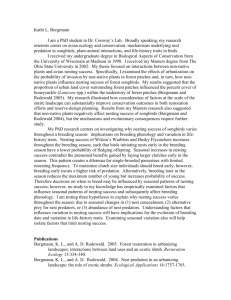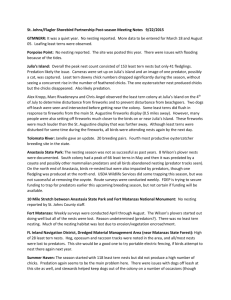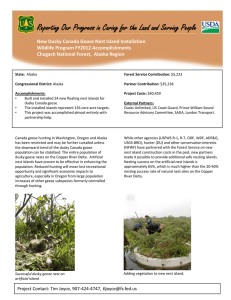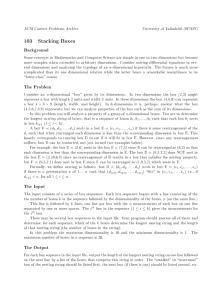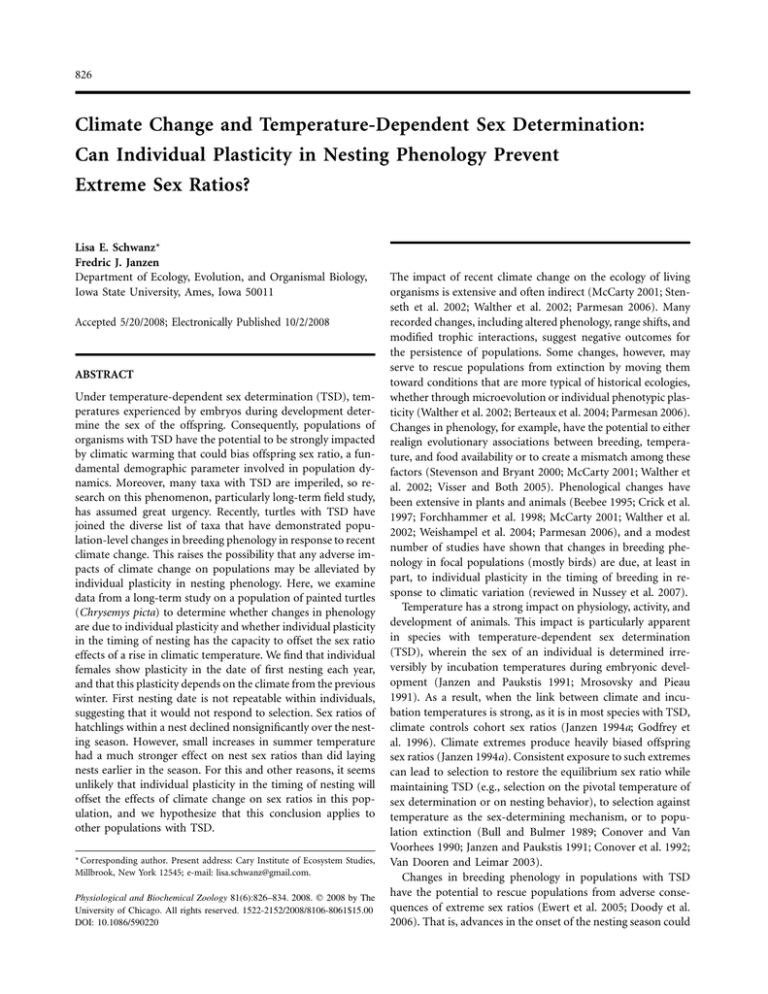
826
Climate Change and Temperature-Dependent Sex Determination:
Can Individual Plasticity in Nesting Phenology Prevent
Extreme Sex Ratios?
Lisa E. Schwanz*
Fredric J. Janzen
Department of Ecology, Evolution, and Organismal Biology,
Iowa State University, Ames, Iowa 50011
Accepted 5/20/2008; Electronically Published 10/2/2008
ABSTRACT
Under temperature-dependent sex determination (TSD), temperatures experienced by embryos during development determine the sex of the offspring. Consequently, populations of
organisms with TSD have the potential to be strongly impacted
by climatic warming that could bias offspring sex ratio, a fundamental demographic parameter involved in population dynamics. Moreover, many taxa with TSD are imperiled, so research on this phenomenon, particularly long-term field study,
has assumed great urgency. Recently, turtles with TSD have
joined the diverse list of taxa that have demonstrated population-level changes in breeding phenology in response to recent
climate change. This raises the possibility that any adverse impacts of climate change on populations may be alleviated by
individual plasticity in nesting phenology. Here, we examine
data from a long-term study on a population of painted turtles
(Chrysemys picta) to determine whether changes in phenology
are due to individual plasticity and whether individual plasticity
in the timing of nesting has the capacity to offset the sex ratio
effects of a rise in climatic temperature. We find that individual
females show plasticity in the date of first nesting each year,
and that this plasticity depends on the climate from the previous
winter. First nesting date is not repeatable within individuals,
suggesting that it would not respond to selection. Sex ratios of
hatchlings within a nest declined nonsignificantly over the nesting season. However, small increases in summer temperature
had a much stronger effect on nest sex ratios than did laying
nests earlier in the season. For this and other reasons, it seems
unlikely that individual plasticity in the timing of nesting will
offset the effects of climate change on sex ratios in this population, and we hypothesize that this conclusion applies to
other populations with TSD.
* Corresponding author. Present address: Cary Institute of Ecosystem Studies,
Millbrook, New York 12545; e-mail: lisa.schwanz@gmail.com.
Physiological and Biochemical Zoology 81(6):826–834. 2008. 䉷 2008 by The
University of Chicago. All rights reserved. 1522-2152/2008/8106-8061$15.00
DOI: 10.1086/590220
The impact of recent climate change on the ecology of living
organisms is extensive and often indirect (McCarty 2001; Stenseth et al. 2002; Walther et al. 2002; Parmesan 2006). Many
recorded changes, including altered phenology, range shifts, and
modified trophic interactions, suggest negative outcomes for
the persistence of populations. Some changes, however, may
serve to rescue populations from extinction by moving them
toward conditions that are more typical of historical ecologies,
whether through microevolution or individual phenotypic plasticity (Walther et al. 2002; Berteaux et al. 2004; Parmesan 2006).
Changes in phenology, for example, have the potential to either
realign evolutionary associations between breeding, temperature, and food availability or to create a mismatch among these
factors (Stevenson and Bryant 2000; McCarty 2001; Walther et
al. 2002; Visser and Both 2005). Phenological changes have
been extensive in plants and animals (Beebee 1995; Crick et al.
1997; Forchhammer et al. 1998; McCarty 2001; Walther et al.
2002; Weishampel et al. 2004; Parmesan 2006), and a modest
number of studies have shown that changes in breeding phenology in focal populations (mostly birds) are due, at least in
part, to individual plasticity in the timing of breeding in response to climatic variation (reviewed in Nussey et al. 2007).
Temperature has a strong impact on physiology, activity, and
development of animals. This impact is particularly apparent
in species with temperature-dependent sex determination
(TSD), wherein the sex of an individual is determined irreversibly by incubation temperatures during embryonic development (Janzen and Paukstis 1991; Mrosovsky and Pieau
1991). As a result, when the link between climate and incubation temperatures is strong, as it is in most species with TSD,
climate controls cohort sex ratios (Janzen 1994a; Godfrey et
al. 1996). Climate extremes produce heavily biased offspring
sex ratios (Janzen 1994a). Consistent exposure to such extremes
can lead to selection to restore the equilibrium sex ratio while
maintaining TSD (e.g., selection on the pivotal temperature of
sex determination or on nesting behavior), to selection against
temperature as the sex-determining mechanism, or to population extinction (Bull and Bulmer 1989; Conover and Van
Voorhees 1990; Janzen and Paukstis 1991; Conover et al. 1992;
Van Dooren and Leimar 2003).
Changes in breeding phenology in populations with TSD
have the potential to rescue populations from adverse consequences of extreme sex ratios (Ewert et al. 2005; Doody et al.
2006). That is, advances in the onset of the nesting season could
Climate Change and Temperature-Dependent Sex Determination 827
move the thermosensitive period of sex determination during
embryonic development to an earlier time in the season when
thermal conditions are cooler or more representative of conditions historically linked to a period later in the season. Plasticity of breeding initiation in response to local climatic variation may allow populations to adjust to a warming climate
and may be adaptive in mitigating the sex ratio effects of historical climatic fluctuations (Houston and McNamara 1992; de
Jong 1995). Indeed, in several populations of turtles with TSD,
the timing of first breeding has been earlier in recent years,
concurrent with climate warming; however, individual phenotypic plasticity has not been investigated thoroughly in these
populations (e.g., Weishampel et al. 2004; Pike et al. 2006).
Painted turtles (Chrysemys picta) in Illinois have hastened
the initiation of breeding over the last 17 yr of study (F. J.
Janzen, unpublished data). Between 1990 and 1996, females in
this population began nesting, on average, on June 4 (Julian
day 155), with the earliest date of May 28. Between 2000 and
2006, nesting initiated around May 26 (Julian day 146), with
the earliest date of May 17. Nesting terminates by the end of
June, and females sometimes produce a second and third clutch
within a season, roughly 2 wk after the previous clutch. Eggs
require approximately 3 mo before hatching, with the thermosensitive phase of sex determination for most embryos in
this population occurring historically in July (Janzen 1994a,
1994b). In C. picta, warm incubation temperatures during embryonic development lead to female offspring, whereas cool
incubation temperatures produce males. Vegetation cover plays
an important role in determining nest temperatures and nest
sex ratios within a year (Janzen 1994b; Weisrock and Janzen
1999), but climate (July air temperature) determines the average
nest sex ratio each year and strongly predicts the cohort sex
ratio (Schwarzkopf and Brooks 1987; Janzen 1994a, 1994b;
Weisrock and Janzen 1999). Thus, one might expect that climatic warming could eventually lead to an extreme overproduction of female offspring, thereby substantially influencing
the ecological and evolutionary dynamics of the population.
In this article, we examine breeding phenology in our population of C. picta and its potential to counteract the effects of
climatic warming on this population, namely on offspring sex
ratio. First, we examine whether individual nesting females
demonstrate plasticity in the timing of first nesting in response
to local winter and spring climate. This study is one of only a
few to utilize extensive longitudinal data from a wild vertebrate
population to investigate phenotypic plasticity in breeding, and
the first to do so in a reptile (Nussey et al. 2007). Second, we
examine whether the timing of first nesting is repeatable within
females in order to assess whether this trait has the potential
to be heritable and responsive to selection. Third, we evaluate
how nest sex ratios correlate with the timing of nesting to
determine how changes in timing by a female might affect her
nest sex ratio. Finally, we step back and explore the population
trends that have been observed during the course of our study
to understand how individual nesting relates to population outcome. Namely, what are the ties between winter and summer
climate, nesting initiation and median nest date, and lay date
and the production of second clutches?
Material and Methods
We monitored a population of painted turtles (Chrysemys picta)
on the Thomson Causeway Recreation Area (TCRA), a small
island in the Mississippi River, near Thomson, Illinois. The
turtle population nests primarily in a ∼1.5-ha area adjacent to
the backwaters of the river. The habitat is a mostly flat, grassy
area interspersed with deciduous and coniferous trees (for more
description of the study site, see Kolbe and Janzen 2002). The
nesting area has been the focus of research on C. picta since
1988, with intensive monitoring for nesting activity between
mid-May and the end of June since 1990.
During the nesting season, the area was checked hourly for
the presence of nesting females from dawn until dusk. Each
nest was mapped and the degree of vegetation cover above the
nest in the four cardinal directions was recorded with a spherical densiometer. The south ⫹ west vegetation cover was used
as a summary value of nest vegetation cover (see Janzen 1994b;
Weisrock and Janzen 1999; Morjan 2003b for more details).
Since 1995, turtles have been captured after nest completion
and individually marked with unique combinations of filings
in the marginal scutes.
In September, all nests that were not depredated were excavated to retrieve offspring. Because hatchling painted turtles
in our population hibernate in their natal nests over the winter,
we can be assured of finding all hatchlings in the nest in September (Janzen 1994b). The hatchlings were moved to Iowa
State University (Ames), where they remained over the winter.
A subset of hatchlings in each nest was euthanized and sexed
via visual examination of the gonads, as described by Janzen
(1994b). Because 66% of nests are typically unisexual (Janzen
1994b), sexing only a portion of hatchlings in each nest allows
us to reasonably estimate the nest sex ratios (proportion of
male individuals).
On the basis of our observations of all nesting events over
each season, the first and median nesting dates for each year
were determined. In some early years of the study, lay dates
were not known for a sufficient number of nests to be able to
confidently assign a median nest date. The proportion of nests
in a year that were second clutches was calculated from the
number of known second clutches and the total number of
nests laid. Because knowledge of second nests requires individual identification of females, the proportion of second nests
could not be determined before 1995.
Climate data were acquired for Clinton, Iowa (∼10 km from
the TCRA) from the National Climate Data Center (NCDC;
http://www.ncdc.noaa.gov). Heating degree-days (HDD) for
the winter before the nesting season (HDD winter) was chosen
as the most appropriate climate measure because of its cumulative nature and its temporal correspondence with egg development. Egg follicles develop to roughly 50% of their energy
content in the fall before egg laying, and the remaining devel-
828 L. E. Schwanz and F. J. Janzen
opment occurs after females emerge from hibernation (Congdon and Tinkle 1982). Such physiological processes are probably highly thermally dependent in these animals. Monthly
HDD values represent the sum of the number of degrees Fahrenheit that each daily mean temperature falls below the base
temperature (base temperature p 65⬚F for NCDC data, or
∼18⬚C). Thus, a higher HDD value indicates that the climate
has been colder, requiring greater heating to reach the base
temperature. Here, HDD values were summed from monthly
values from Clinton for September through April. Mean May
air temperature was also explored as a potential predictor of
the onset of nesting for the population, but it had no explanatory power. Mean May, June, and July air temperatures were
from summary data provided by the NCDC. Monthly air temperatures were available from 1931, whereas winter HDD values
could be calculated starting with the year 1952.
To examine plasticity in the timing of first nesting for individual females, the analysis was restricted to only those females that nested in at least 3 yr between 1995 and 2006 (not
necessarily in consecutive years). This subset of data contained
1,322 nesting records for 268 females. We used linear mixed
models to examine plasticity in first nesting date for individual
females (e.g., Nussey et al. 2005b, 2007). A value for HDD
winter just before nesting was entered as a fixed effect and year
was entered as a random effect to account for variation among
years in nesting date that was not due to winter climate. The
importance of the random effects of female identity and female
# HDD winter for the model were determined using likelihood
ratio tests from random regression models, referencing the test
statistic to a x2 distribution (where degrees of freedom are given
by the difference in the number of parameters between the two
models). The climate variable (HDD winter) allows us to test
for plasticity (i.e., the reaction norm), and female identity and
interaction test for differences in height and slope of the reaction norms, respectively, due to differences in individual-level
attributes, such as genes or developmental factors.
The same data subset (females nesting at least three times)
was used to test for repeatability (r) within females in the timing
of first nesting. A one-way ANOVA with female identity as the
predictor of first nesting date provided values of variance within
and among females. Repeatability in nesting date, which ranges
between 0 and 1, was calculated using Equations (2)–(5) in
Lessels and Boag (1987).
To examine whether nest sex ratios vary according to nesting
date, we examined all nests produced by females of known
identity, including nests from females with fewer than three
nesting years and nests that were second and third clutches
from females within a year. A generalized linear mixed model
with binomial error structure and logit link (SAS ver. 9.1, June
2006 release of PROC GLIMMIX) tested for the importance
of nesting date (in Julian days; covariate), vegetation cover
(covariate), mean July air temperature (covariate), and the interaction between July temperature and nesting date for the
response variable, nest sex ratio. Female identity was entered
as a random effect in this model to account for repeated mea-
sures of females. The data were overdispersed, so we added a
multiplicative overdispersion parameter to the model statement.
The overall effects of nesting phenology were examined using
linear regressions of median nesting date and proportion of
second clutches on first nesting date and year. In addition, the
probability of laying a second clutch for each female in a year
(1 p second clutch, 0 p no second clutch) was related to lay
date of the first nest using a logistic regression, with female
identity entered as a random effect. For this analysis, the data
set included all females of known identity, regardless of the
number of years in which they nested. All statistical analyses
were performed with JMP 6, with the exception of the sex ratio
model.
Results
Climate and Phenology
Over the course of this study (1990–2006), there was no significant change in mean air temperature for the months of May
(r 2 p 0.00, P p 0.84, N p 17), June (r 2 p 0.01, P p 0.66,
N p 17), or July (r 2 p 0.11, P p 0.20, N p 17), or for winter
HDD (r 2 p 0.12, P p 0.17, N p 17). During our study, the
date of first nesting for the population each year was strongly
correlated with winter climate, with warmer winters leading to
earlier first nesting dates (r 2 p 0.71 , P ! 0.0001, N p 16; first
nest date p 77.55 ⫹ 0.012 # HDD winter; Fig. 1).
Plasticity and Individual Nesting Events
Females demonstrated plasticity in their first nesting date in
response to winter climate (Tables 1, 2). Following warmer
winters (lower HDD winter values), females laid their first nests
Figure 1. First nesting date (Julian days) of each year for our painted
turtle population is earlier after warmer winters (fewer heating degreedays [HDD]; September–April). A Julian day of 150 corresponds to
May 30, excluding leap years. HDD winter p HDD for the winter
before the nesting season.
Climate Change and Temperature-Dependent Sex Determination 829
Table 1: Significance of adding random effects to linear mixed models of first nesting date for individual females
Random Variables
Year
Year ⫹ female (elevation)
Year ⫹ female (elevation) ⫹ female # HDD winter (slope)
⫺2 Log Likelihood
9,340.46
9,335.61
9,326.88
Test
1 vs. 2
2 vs. 3
d df
Likelihood Ratio
P Value
1
2
4.85
8.73
!.05
!.05
Note. Heating degree-days for the winter before the nesting season (HDD winter) was a fixed effect that was entered into all models. The data include the
first nests of females that were known to have nested in at least 3 yr between 1995 and 2006.
earlier in the spring (Fig. 2). In addition, females differed significantly in the elevation and slope of their plastic response
(Tables 1, 2). First nesting date was not repeatable within females (r p 0.03, N p 268).
Nest sex ratios became more female biased as the laying date
of a nest occurred later in the season, but this tendency was
not significant (Table 3). The interaction between July temperature and laying date was not significant and was subsequently removed from the final model. Vegetation cover had
a positive influence on nest sex ratios. In other words, shadier
nests produced more male-biased sibships than did less vegetated nests; an increase of 1% in south ⫹ west vegetation cover
(maximum 200%) leads to a 2% increase in probability of
producing sons in a nest. July air temperature had a significant
effect on nest sex ratio, with lower nest sex ratio (i.e., more
females) predicted when July is warmer (for a given nesting
date and vegetation cover). A 1⬚C rise in July air temperature
from the 1931–2006 mean (from 23.9⬚C to 24.9⬚C) leads to a
∼50% reduction in the sex ratio of a nest.
Population-Level Consequences of Plasticity
Winter climate (HDD winter) did not predict mean air temperatures in May (r 2 p 0.07, P p 0.30; N p 17 for all), June
(r 2 p 0.04, P p 0.45), or July (r 2 p 0.15, P p 0.12) during our
study. Over a greater time frame (1952–2006), warmer winters
were correlated with warmer air temperatures in July (r 2 p
0.14, P p 0.005; N p 55 for all) but not in May (r 2 p 0.04,
P p 0.13) or June (r 2 p 0.02, P p 0.26). During our study,
July air temperatures were not predicted by air temperatures
in May (r 2 p 0.00, P p 0.97), when nesting begins, but they
did tend to correlate positively with air temperatures in June
(r 2 p 0.21, P p 0.07), which is the month when the majority
of nests are laid. A similar pattern was seen with May, June,
and July temperatures from 1931 to 2006.
The median nesting date for each year was positively correlated with the first nesting date, but the relationship was
allometric (r 2 p 0.50, P p 0.0045, N p 14; median nest
date p 100.14 ⫹ 0.432 # first nest date; Fig. 3A). As a result,
median nesting date has not occurred earlier over the course
of this study (median nest date vs. year; r 2 p 0.06, P p 0.39,
N p 14; Fig. 3B).
The production of a subsequent clutch within a year was
more likely for females that laid earlier first nests that year
(P(first nest date) ! 0.0001, P(female) p 1, n nests p 1,822; Fig.
3C). The proportion of nests that are constructed second in a
season is not significantly predicted by the first nesting date
for the population (r 2 p 0.23, P p 0.11, N p 12; note that
power in this test [0.19] was quite low), but the frequency of
second nests has increased over the course of the study
(r 2 p 0.60, P p 0.003, N p 12; Fig. 3D).
Discussion
Few studies to date have used longitudinal data to test phenotypic plasticity in wild vertebrates, and the majority has focused on bird populations (Nussey et al. 2007). Here, we take
advantage of an extensive longitudinal data set on breeding in
female painted turtles to provide, to the best of our knowledge,
the first evidence of within-individual breeding plasticity in wild
reptiles. Female painted turtles demonstrated plasticity in the
timing of their first nesting event each year. This plasticity was
linked to winter climate, with females nesting earlier after
warmer winters.
The mechanisms behind this individual plasticity in annual
onset of nesting are largely unknown. However, several potential mechanisms exist. First, ambient temperature may directly
influence the date on which females can emerge from hibernation and resume egg development, or it may directly influence the rate of egg development during fall and spring through
the availability of basking opportunities (Moll 1973; Congdon
and Tinkle 1982; Stevenson and Bryant 2000). Second, temperatures may influence the timing of food resources available
for female metabolism and egg completion (Walther et al.
2002).
Plasticity in the timing of first nesting clearly contributes to
the observed correlations between the first nesting date of the
population and winter climate. Microevolution of nesting timing per se is unlikely to have contributed to this population
trend because of the lack of repeatability (and, hence, heritability) in nesting timing. Immigration of females from populations with earlier nesting phenology is also a possible contributor to changes in nesting phenology over the course of
this study, although it is unlikely given the low variation in
nesting dates among Chrysemys picta populations across a wide
geographic range (Moll 1973; Morjan 2003b; F. J. Janzen, unpublished data).
The phenotypic plasticity observed in female painted turtles
in our population seems unlikely to prevent future biased sex
ratios caused by climate warming (Janzen 1994a; Morjan
2003a) for several reasons. First, although nests laid earlier in
the season produced more males in previous studies on C. picta
830 L. E. Schwanz and F. J. Janzen
(Bowden et al. 2000), the seasonal effect on our population
was modest compared with the sex effects of climate. If the
parameter estimate from our statistical model is accurate, then
a nest laid 1 d earlier experiences a 1% increase in sex ratio.
If summers warm by 1⬚C over the next 30 yr (IPCC 2001; Pan
et al. 2004), nests laid on a given date will be half as likely to
produce sons, and a nest must be laid ∼60 d earlier to offset
the effect of climate (63 d for a doubling of the nest sex ratio).
Female painted turtles would need to begin nesting in late
March to counteract this climate effect. If every month of the
winter (September–April) warms by 1⬚C from the 1931–2006
average, this pattern would lower the HDD winter value from
a historical average of 6,000 degree-days to 5,500 degree-days.
Such a change of 500 degree-days is predicted to move a female’s first nesting date forward by 4 d (on the basis of the
predicted reaction norm) and the population’s first nesting date
forward by 6 d (on the basis of the relationship between the
population’s first nesting date and the HDD winter value).
Clearly, this change in the timing of breeding cannot offset the
influence of climate on nest sex ratios.
This prediction, of course, assumes that annual climate profiles remain the same, raised by some constant across the entire
year. This pattern may not hold true. Although we found a
positive correlation over the past 50 yr between winter and July
climates, geographically broader climate patterns over the past
30 yr indicate that the south-central United States has not
uniformly experienced increases in summer temperatures to
match those observed in the rest of the country and in the
winter (IPCC 2001; Pan et al. 2004). Indeed, in Clinton, Iowa,
July air temperatures have not changed from 1931 to 2006
(duration of climate data available for Clinton; r 2 p 0.03,
P p 0.15, N p 76), whereas winters have warmed significantly
since 1952 (when HDD winter values are first available; r 2 p
0.07, P p 0.05, N p 55). This summer “warming hole” is predicted to lead to summer temperatures warming to a lesser
extent over the next 30 yr than winter temperatures (Pan et
al. 2004). Such asymmetries in climate warming may lead to
asynchrony between breeding and resource availability (Stevenson and Bryant 2000; McCarty 2001; Visser and Both 2005;
Parmesan 2006). For painted turtles in Illinois, this could mean
a mismatch between the timing of the embryonic thermosensitive period of sex determination and thermal conditions. That
Figure 2. Reaction norms of first nesting date (Julian days) for individual female painted turtles, as a function of winter climate. Most
females nested earlier after warmer winters (fewer heating degree-days
[HDD]; September–April). Females differed significantly in elevation
and slope of the reaction norms. HDD winter p HDD for the winter
before the nesting season.
is, nests laid earlier may actually experience cooler incubation
temperatures than normal given that mean air temperature for
June averages 2⬚C cooler than for July (1931–2006) and that
nest temperatures tend to mirror fluctuations in air temperatures (Weisrock and Janzen 1999). Under this scenario, climate
warming could counterintuitively lead to the overproduction
of male offspring, again rendering plasticity in nest timing ineffective in offsetting climate effects. Furthermore, if a 1⬚C rise
in summer temperatures reduces a nest’s sex ratio by half, HDD
winter would need to be reduced to 0–1,000 degree-days to
effect a 60-d advance in nesting date and a doubling of nest
sex ratio. One thousand heating degree-days would be exceeded
if as few as 100 d between September and April had a daily
mean air temperature below 55⬚F, indicating that the warming
asymmetry would have to be extreme to offset the sex ratio
effects of a modest rise in summer temperatures.
The final reason that individual plasticity is unlikely to counteract the effects of climate warming is that females are more
likely to lay a second clutch when their first nest is laid early.
As a result, the proportion of nests each year that are second
Table 2: Estimates of fixed and random effects from the final linear mixed model for first nesting date
Effect
Fixed:
HDD winter
Random:
Year
Female (elevation)
Female # HDD winter (slope)
Residual
Estimate
.0079
SE
.002
P Value
Variance Component
SE
.0028
Note. HDD winter p heating degree-days for the winter before the nesting season.
9.61
2.21
⫺1.4 # 10⫺5
67.09
4.60
1.46
3.83 # 10⫺6
3.17
Climate Change and Temperature-Dependent Sex Determination 831
Table 3: Results from a generalized linear mixed model of nest sex ratio (proportion male),
with binomial error structure and logit link
Predictor
Nesting date
Nest vegetation
July temperature
Log Odds Ratio
Numerator df
Denominator df
F Value
P Value
⫺.011
.021
⫺.697
1
1
1
793.7
830.9
819.4
2.42
128.19
94.02
!.0001
!.0001
.120
Note. Female identity was entered as a random effect, and we included a multiplicative overdispersion parameter
to account for overdispersion of nest sex ratio. Data include all nests where offspring were sexed that were from females
with known identity between 1995 and 2006 (839 nests).
nests has increased and the median date of nesting has not
changed significantly. Perhaps as a consequence, July air temperatures have remained important for sexual differentiation
in a majority of nests and for cohort sex ratios in this population (F. J. Janzen, unpublished data). If this pattern continues,
altered phenology will not “save” the majority of embryos from
overly warm Julys because most nests will not shift into cooler,
earlier portions of the season.
If plasticity fails to prevent the overproduction of female
hatchlings, microevolution may bring the sex ratio back to
equilibrium via selection on pivotal temperatures or nest-site
selection (Morjan 2003a). For example, the evolution of maternal nest-site selection toward wetter or shadier nests would
lead to cooler nests, thus mitigating the effects of warmer air
temperatures. The evolution of nesting behavior has clearly
been historically important in responding to local climate across
geographic ranges in species with TSD (Bull et al. 1982; Morjan
2003b; Ewert et al. 2005; Doody et al. 2006). If climate change
is too rapid and extreme, the repeated production of extremely
female-biased cohort sex ratios would lead to a deficiency in
reproductive males in the population and, potentially, to extinction (Janzen 1994a; Morjan 2003a; L. J. Harmon and F. J.
Janzen, unpublished data).
Prospectus for Future Research
Turtles have joined the growing list of taxa exhibiting phenological shifts in response to climate change (McCarty 2001;
Walther et al. 2002; Weishampel et al. 2004; Parmesan 2006;
Pike et al. 2006; Hawkes et al. 2007; F. J. Janzen, unpublished
data). Here we have shown that this change in phenology in
one population of painted turtles is the product of labile nesting
dates within females. This plasticity as it currently exists does
not seem adequate to offset the potentially negative effects of
climatic warming on offspring sex ratios. Several future avenues
of research may provide further insight into the role of plasticity
in mitigating negative impacts of climate change on populations
with TSD.
First, additional maternal traits (selection of nest cover and
egg hormone deposition) influence nest sex ratios in painted
turtles (Janzen 1994b; Weisrock and Janzen 1999; Bowden et
al. 2000) and in other species with TSD. These traits should
be examined for plasticity in response to climate fluctuations
to determine whether they could contribute to mitigation of
climate effects on offspring sex ratios.
Second, the individual variation in the elevation and slope
of reaction norms of nesting date (Table 1; Fig. 2) suggest
further examination of individual-level differences in plasticity
in this system (Nussey et al. 2007). Plasticity in nesting itself
may be condition dependent (Nussey et al. 2005a) and sensitive
to effects from early life or constraints on adults. External effects
on plasticity are an important future avenue of research because
of the potential for climate change to alter early life conditions
and to impose external constraints. Additionally, plasticity may
be heritable and could evolve in response to climate change
(de Jong 1995). Estimation of the heritability and fitness consequences of nesting plasticity is not only of interest in basic
evolutionary biology but would also allow predictions of how
plasticity may evolve in response to climate change.
Third, a mechanistic model of offspring sexual outcome
would allow more detailed investigation of the direct and indirect ways climate may impact offspring sex. Such a model
should include the effects of nest temperature profiles (from
nest cover and air temperature profiles), yolk provisioning, and
yolk hormones on offspring developmental rate, sex, and viability (e.g., Georges et al. 2005; Les et al. 2007). When this
mechanistic model is informed by climate-induced changes in
(1) nesting date, (2) production of second and third clutches
(which are depleted in yolk provisions and show altered hormone composition; Bowden et al. 2000, 2004; Harms et al.
2005), and (3) seasonal and daily patterns in climate, we can
estimate the outcome for the overall offspring sex ratio. In this
study, we have addressed the first two climate impacts. These
efforts would advance if we determined the triggers of nesting
plasticity, allowing better extrapolation of this response to predicted future climate change.
Climate change poses a serious threat to the persistence of
populations of organisms exhibiting environmental sex determination, many of which are already imperiled for other reasons. Clutch sex ratios vary across seasons and oviposition
microhabitats in most systems with TSD that have been studied
(e.g., Conover and Kynard 1981; Janzen and Paukstis 1991;
Godfrey et al. 1996), indicating that adjustment of the sex ratio
to climate change is possible. Climate has a strong influence
on offspring sex ratios in our study population, leading us to
speculate whether our results for painted turtles extend in gen-
832 L. E. Schwanz and F. J. Janzen
Figure 3. Consequences of phenotypic plasticity in nesting date. In A, median nesting date is positively correlated with first nesting date, but
in B, it has not been made earlier during the course of the study, in contrast with first nesting date. This result is likely explained by C, early
nesting by a female increasing the chances that she will lay a second clutch in the season at a later date (symbol size indicates counts at the
data point). D, Proportion of nests laid in a year that are second clutches has increased during this study.
eral to other TSD-exhibiting populations. Specifically, is climate
typically such a strong contributor to nest sex ratio that it
overwhelms the effects of variation in nest-specific attributes?
Clearly, the question of whether population changes will be
enough to offset climate change is one of primary interest in
all studies of plasticity and climate change and phenological
responses to climate (Ewert et al. 2005; Visser and Both 2005;
Doody et al. 2006). The addition of more population-focused
studies will determine whether any generalities can be made.
In particular, the results of this study underscore the applied
importance, as well as the basic importance, of understanding
the ecology and evolution of phenotypic plasticity (particularly
labile traits). Such studies can be accomplished only through
examination of extensive longitudinal data. The value of longterm data for retrospective and predictive analyses is immeasurable, and our reliance on such data for studies of the biotic
impact of climate change will surely increase in the future.
Acknowledgments
We thank the many tireless students and researchers who participated in the Janzen lab turtle camp crew. The Army Corps
of Engineers provided access to the Thomson Causeway Recreation Area, the U.S. Fish and Wildlife Service and the Illinois
Department of Natural Resources provided collecting permits,
and the project received continuing Institutional Animal Care
and Use Committee approval from Iowa State University (ISU).
D. Warner and two anonymous reviewers suggested improvements to the manuscript. M.-Y. Yum and the ISU Department
of Statistics provided statistical consultation. Primary funding
for the long-term fieldwork was provided by National Science
Foundation (NSF) grants (DDIG BSR8914686, DEB9629529,
LTREB DEB0089680, LTREB DEB0640932, and UMEB
IBN0080194) to F.J.J. During the preparation of this manuscript, L.E.S was supported by an NSF postdoctoral fellowship
in biological informatics.
Literature Cited
Beebee T.J.C. 1995. Amphibian breeding and climate. Nature
374:219–220.
Berteaux D., D. Reale, A.G. McAdam, and S. Boutin. 2004.
Keeping pace with fast climate change: can Arctic life count
on evolution? Integr Comp Biol 44:140–151.
Climate Change and Temperature-Dependent Sex Determination 833
Bowden R.M., M.A. Ewert, and C.E. Nelson. 2000. Environmental sex determination in a reptile varies seasonally and
with yolk hormones. Proc R Soc B 267:1745–1749.
Bowden R.M., H.K. Harms, R.T. Paitz, and F.J. Janzen. 2004.
Does optimal egg size vary with demographic stage because
of a physiological constraint? Funct Ecol 18:522–529.
Bull J.J. and M.G. Bulmer. 1989. Longevity enhances selection
of environmental sex determination. Heredity 63:315–320.
Bull J.J., R. Vogt, and C. McCoy. 1982. Sex determining temperatures in turtles: a geographic comparison. Evolution 36:
326–332.
Congdon J.D. and D.W. Tinkle. 1982. Reproductive energetics
of the painted turtle (Chrysemys picta). Herpetologica 38:
228–237.
Conover D.O. and B.E. Kynard. 1981. Environmental sex determination: interaction of temperature and genotype in a
fish. Science 213:577–579.
Conover D.O. and D.A. Van Voorhees. 1990. Evolution of a
balanced sex ratio by frequency-dependent selection in a fish.
Science 250:1556–1558.
Conover D.O., D.A. Van Voorhees, and A. Ehtisham. 1992. Sex
ratio selection and the evolution of environmental sex determination in laboratory populations of Menidia menidia.
Evolution 46:1722–1730.
Crick H.Q.P., C. Dudley, D.E. Glue, and D.L. Thomson. 1997.
UK birds are laying eggs earlier. Nature 388:526.
de Jong G. 1995. Phenotypic plasticity as a product of selection
in a variable environment. Am Nat 145:493–512.
Doody J.S., E. Guarino, A. Georges, B. Corey, G. Murray, and
M. Ewert. 2006. Nest site choice compensates for climate
effects on sex ratios in a lizard with environmental sex determination. Evol Ecol 20:307–330.
Ewert M.A., J.W. Lang, and C.E. Nelson. 2005. Geographic
variation in the pattern of temperature-dependent sex determination in the American snapping turtle (Chelydra serpentina). J Zool (Lond) 265:81–95.
Forchhammer M.C., E. Post, and N.C. Stenseth. 1998. Breeding
phenology and climate. Nature 391:29–30.
Georges A., K. Beggs, J.E. Young, and J.S. Doody. 2005. Modeling development of reptile embryos under fluctuating temperature regimes. Physiol Biochem Zool 78:18–30.
Godfrey M.H., R. Barreto, and N. Mrosovsky. 1996. Estimating
past and present sex ratios of sea turtles in Suriname. Can
J Zool 74:267–277.
Harms H.K., R.T. Paitz, R.M. Bowden, and F.J. Janzen. 2005.
Age and season impact resource allocation to eggs and nesting behavior in the painted turtle. Physiol Biochem Zool 78:
996–1004.
Hawkes L., A.C. Broderick, M.H. Godfrey, and B.J. Godley.
2007. Investigating the potential impacts of climate change
on a marine turtle population. Global Change Biol 13:923–
932.
Houston A.I. and J.M. McNamara. 1992. Phenotypic plasticity
as a state-dependent life-history decision. Evol Ecol 6:243–
253.
IPCC (Intergovernmental Panel on Climate Change). 2001. Climate Change 2001: The Scientific Basis. J.T. Houghton, Y.
Ding, D.J. Griggs, M. Noguer, P.J. van der Linden, X. Dai,
K. Maskell, and C.A. Johnson, eds. Cambridge University
Press, Cambridge.
Janzen F.J. 1994a. Climate change and temperature-dependent
sex determination in reptiles. Proc Natl Acad Sci USA 91:
7487–7490.
———. 1994b. Vegetational cover predicts the sex ratio of
hatchling turtles in natural nests. Ecology 75:1593–1599.
Janzen F.J. and G.L. Paukstis. 1991. Environmental sex determination in reptiles: ecology, evolution, and experimental
design. Q Rev Biol 66:149–179.
Kolbe J.J. and F.J. Janzen. 2002. Spatial and temporal dynamics
of turtle nest predation: edge effects. Oikos 99:538–544.
Les H.L., R.T. Paitz, and R.M. Bowden. 2007. Experimental test
of the effects of fluctuating incubation temperatures on
hatchling phenotype. J Exp Zool 307A:274–280.
Lessels C.M. and P.T. Boag. 1987. Unrepeatable repeatabilities:
a common mistake. Auk 104:116–121.
McCarty J.P. 2001. Ecological consequences of recent climate
change. Conserv Biol 15:320–331.
Moll E.O. 1973. Latitudinal and intersubspecific variation in
reproduction of the painted turtle, Chrysemys picta. Herpetologica 29:307–318.
Morjan C.L. 2003a. How rapidly can maternal behavior affecting primary sex ratio evolve in a reptile with environmental sex determination? Am Nat 162:205–219.
———. 2003b. Variation in nesting patterns affecting nest temperatures in two populations of painted turtles (Chrysemys
picta) with temperature-dependent sex determination. Behav
Ecol Sociobiol 53:254–261.
Mrosovsky N. and C. Pieau. 1991. Transitional range of temperature, pivotal temperatures and thermosensitive stages for
sex determination in reptiles. Amphib-Reptilia 12:169–179.
Nussey D.H., T.H. Clutton-Brock, S.D. Albon, J. Pemberton,
and L.E.B. Kruuk. 2005a. Constraints on plastic responses
to climate variation in red deer. Biol Lett 1:457–460.
Nussey D.H., T.H. Clutton-Brock, D.A. Elston, S.D. Albon, and
L.E.B. Kruuk. 2005b. Phenotypic plasticity in a maternal trait
in red deer. J Anim Ecol 74:387–396.
Nussey D.H, A.J. Wilson, and J.E. Brommer. 2007. The evolutionary ecology of individual phenotypic plasticity in wild
populations. J Evol Biol 20:831–844.
Pan Z., R.W. Arritt, E.S. Takle, W.J. Gutkowski Jr., C.J. Anderson, and M. Segal. 2004. Altered hydrologic feedback in
a warming climate introduces a “warming hole.” Geophys
Res Lett 31:L17109.
Parmesan C. 2006. Ecological and evolutionary responses to
recent climate change. Annu Rev Ecol Evol Syst 37:637–669.
Pike D.A., R.L. Antworth, and J.C. Stiner. 2006. Earlier nesting
contributes to shorter nesting seasons for the loggerhead sea
turtle, Caretta caretta. J Herpetol 40:91–94.
834 L. E. Schwanz and F. J. Janzen
Schwarzkopf L. and R.J. Brooks. 1987. Nest-site selection and
offspring sex ratio in painted turtles, Chrysemys picta. Copeia
1987:53–61.
Stenseth N.C., A. Meyssterud, G. Ottersen, J.W. Hurrell, K.-S.
Chan, and M. Lima. 2002. Ecological effects of climate fluctuations. Science 297:1292–1296.
Stevenson I.A.R. and D.M. Bryant. 2000. Climate change and
constraints on breeding. Nature 406:366–367.
Van Dooren T.J.M. and O. Leimar. 2003. The evolution of
environmental and genetic sex determination in fluctuating
environments. Evolution 57:2667–2677.
Visser M.E. and C. Both. 2005. Shifts in phenology due to global
climate change: the need for a yardstick. Proc R Soc B 272:
2561–2569.
Walther G.-R., E. Post, P. Convey, A. Menzel, C. Parmesan,
T.J.C. Beebee, J.-M. Fromentin, O. Hoegh-Guldberg, and F.
Bairlein. 2002. Ecological responses to recent climate change.
Nature 416:389–395.
Weishampel J.F., D.A. Bagley, and L.M. Ehrhart. 2004. Earlier
nesting by loggerhead sea turtles following sea surface warming. Global Change Biol 10:1424–1427.
Weisrock D.W. and F.J. Janzen. 1999. Thermal and fitnessrelated consequences of nest location in painted turtles
(Chrysemys picta). Funct Ecol 13:94–101.



